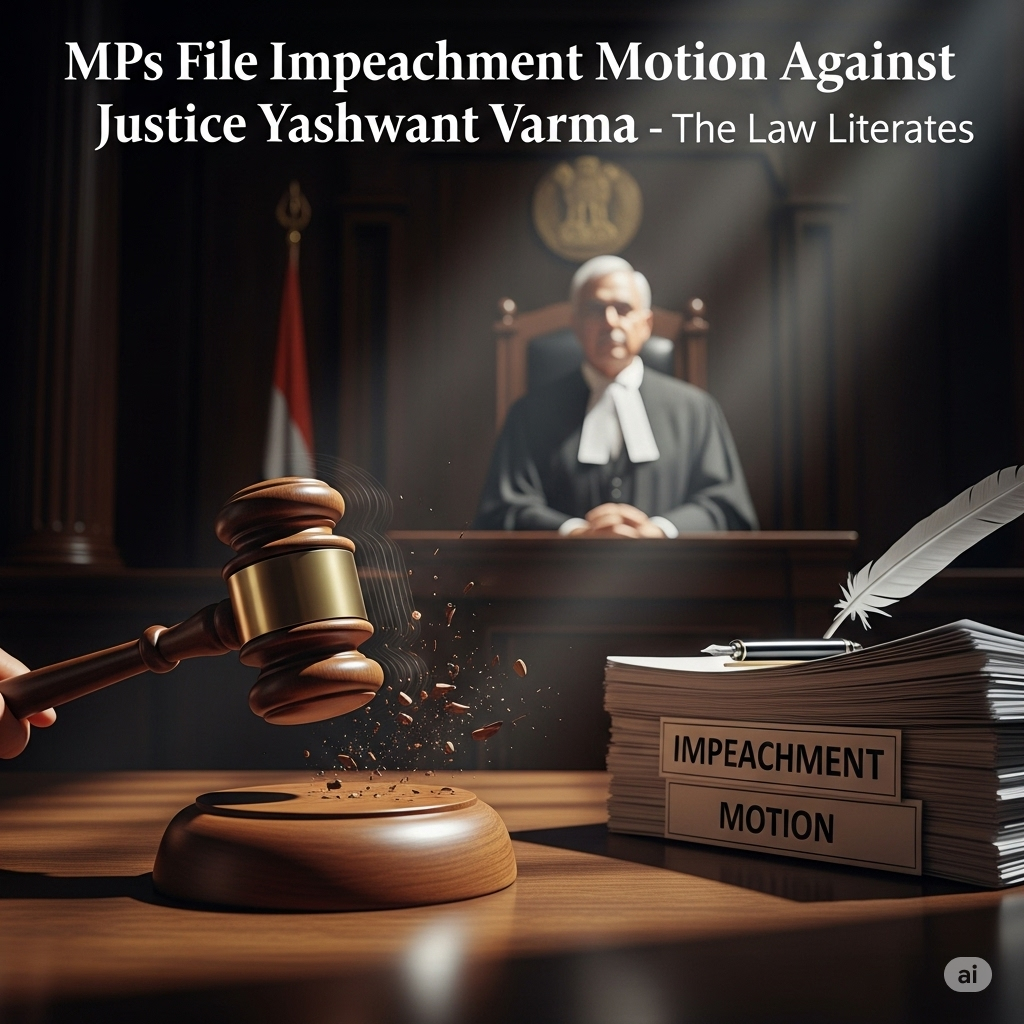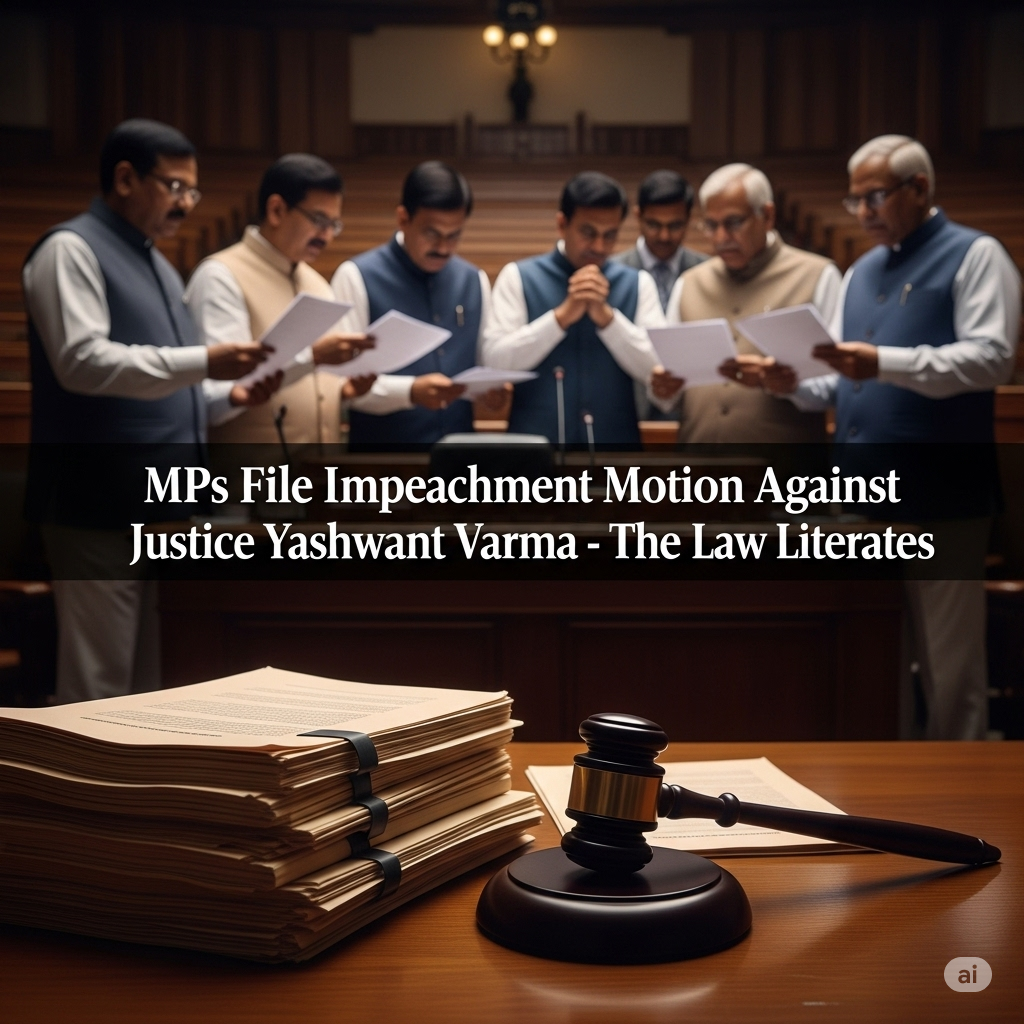Historic Move: MPs File Impeachment Motion Against Justice Yashwant Varma – The Law Literates
Introduction
The impeachment motion against Justice Yashwant Varma has created a debate among the legal and political corridors of India, bringing the rare and delicate question of judicial accountability back into sharp focus. On July
21, 2025, as the Monsoon Session of Parliament began, over 200 Members of Parliament – 145 MPs in the Lok Sabha and 63 in the Rajya Sabha submitted a formal notice to initiate impeachment proceedings against Justice Yashwant Varma of the Allahabad High Court, previously a Delhi HC judge in an unprecedented step of formally seeking the removal of a sitting High Court judge for alleged grave misconduct. The discovery of large sums of burnt cash at Justice Varma’s official residence has triggered a constitutional process that tests not only the integrity of India’s higher judiciary but also Parliament’s resolve and capacity to hold it accountable. This development could mark a historic turning point in India’s constitutional history, shaping how allegations against the judiciary are handled and scrutinised. “Cash-at-Home” Scandal In the late night of March 14, 2025, a fire erupted at Justice Varma’s official residence in Delhi. Firefighters responding to the news stumbled upon stacks of burnt and half-burnt ₹500 notes in a storeroom adjacent to the residence an astonishing and troubling discovery .
In May, former Chief Justice of India Sanjiv Khanna formed a three-judge in‑house committee. Over ten days, the committee examined 55 witnesses, reviewed CCTV footage, and visited the premises. The committee concluded
that the piles of cash were located in a storeroom under “covert or active control” of Justice Varma and his family & He and his family had not provided a plausible account of the money’s origin. The incident leveled allegations of serious misconduct which were considered “grave enough” to warrant removal. Finally, the panel’s report, forwarded to the President and Prime Minister, endorsed the initiation of impeachment proceedings.
Impeachment Procedure
Under the Constitution (Articles 124, 217, 218) and the Judges (Inquiry) Act, 968, the removal of a Supreme or High Court judge can occur on grounds of “proved misbehaviour” or “incapacity.” For proceedings to begin, A motion must be introduced in either House of Parliament and It must be signed by at least 100 Lok Sabha MPs or 50 Rajya
Sabha MPs. In this case, signatures crossed both thresholds: 145 in Lok Sabha and 63 in Rajya Sabha . Once the motion is submitted to the Speaker (Lok Sabha) and Chairman (Rajya Sabha), they decide whether to admit it. Given both Houses submitted notices on the same day, the Judges (Inquiry) Act mandates the formation of a three-member committee comprising a Supreme Court judge, a High Court Chief Justice, and a distinguished jurist to investigate the
allegations . The committee’s report is expected within three months. If it finds the motion valid and meritorious, both Houses will debate and vote on the removal. A two-thirds majority of those present and voting, plus a simple
majority of the total membership of each House, is required for impeachment.
What lies Ahead
Justice Varma has denied wrongdoing, asserting that he and his family had no knowledge of the money and the storeroom where the cash was found wasn’t part of their living area, and had access independent of them. He
even said that the situation is part of a “conspiracy” against him. Moreover, he has approached the Supreme Court, challenging, 1. The constitutionality of the in-house inquiry 2. The process and fairness of the proceedings 3. The
legal basis and jurisdiction of the three-judge committee 4. Several procedural irregularities in the inquiry report’s findings. With submissions in both Houses, the next move is for the Speaker and Chairman to officially admit the motions. Then, a joint inquiry committee must be formed. According to the Judges (Inquiry) Act, No committee is set
up unless notices are admitted in both Houses and Once admitted, Om Birla (Lok Sabha Speaker) and (Rajya Sabha Chairman) will jointly appoint the committee. The committee has up to 3 months to complete its investigation
and submit its report. Only after the committee submits its findings will Parliament debate the matter and vote. Given the need for a supermajority, this will be a critical test of party unity and cross party consensus.
Conclusion
This unprecedented impeachment motion marks a watershed moment for India’s judicial and parliamentary history. While previous attempts to impeach High Court judges like those against Justice V. Ramaswami in 1993 and Justice Soumitra Sen in 2011 fell through due to resignations, the proceedings against Justice Yashwant Varma may well become the first true test of how far India’s constitutional framework can go to enforce accountability at the highest levels of the judiciary. The outcome will not just decide Justice Varma’s future but will also set vital precedents for the delicate balance between judicial independence and parliamentary oversight. At a time when public trust in institutions is increasingly fragile, how this process unfolds will shape confidence in the rule of law itself.
Whether this impeachment strengthens faith in an impartial system or exposes gaps that need urgent reform, and its verdict will resonate far beyond the walls of Parliament and the courts. This case tests the integrity of internal judicial accountability mechanisms especially Supreme Court in-house inquiries. It challenges parliamentary oversight of the judiciary and sets the stage for how the legislature can act against a sitting judge. Public confidence in the legal system is at stake and this move could restore faith in judicial accountability but this will be very important to see how both
the parliament and the supreme court will develop mutual consensus to deliver justice.
Aryan Shrivastav (LC1, Law Faculty Delhi)
All rights Reserved (Adv Vaibhav Tomar)


